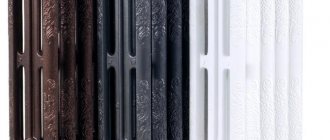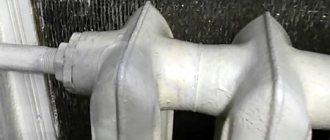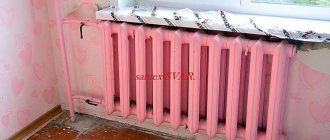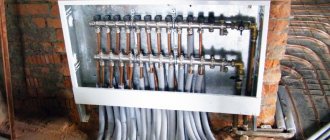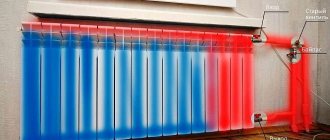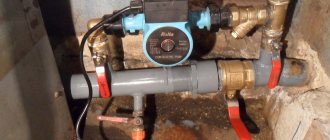Replacing heating batteries in an apartment can entail a number of significant costs. Many homeowners in apartment buildings (hereinafter referred to as MKD) know this. If we talk about the fact that even heating radiators located inside apartments can belong to common property, then not every person knows about this.
In certain situations, the apartment owner does not have to change batteries at his own expense. Their timely replacement and maintenance in proper condition, elimination of leaks and other problems may be the responsibility of the management company (hereinafter referred to as the management company). Moreover, unauthorized replacement of batteries can be considered by law a violation of the rules for using residential premises in an apartment building, which entails a fine of up to 1.5 thousand rubles (according to Article 7.21 of the Code of Administrative Offenses of the Russian Federation).
We will talk about these and other features of replacing heating batteries in an apartment in this article.
Whose property are apartment radiators and pipes?
Heating radiators inside apartments in multi-unit apartment buildings may be classified as common property. This is regulated by the following legislative acts:
- Housing Code of the Russian Federation - see Article 36, Part 1.
- Civil Code of the Russian Federation - see Art. 290 part 1.
- RF PP No. 491 dated 08/13/2006 introduced into the rank of a legislative act the Rules for the maintenance of common property in MKD - see paragraphs 5 and 6 of these Rules (hereinafter referred to as the Rules for the operation of MKD).
In all of these acts of legislation, it is noted that radiators/heating radiators inside an apartment are classified as common property when they are part of a common system and serve more than one room.
If there is no shut-off valve on the riser in your apartment that allows you to disconnect the radiator from the general heating system, this is common property, and its maintenance in proper condition is the responsibility of the management company.
If there are shut-off valves on the pipes in front of the battery, repairing leaks in the central heating system radiators themselves or replacing them with more modern equipment is the responsibility of the homeowner. In this case, radiators will not be classified as common property - this is stipulated in paragraph 5 of the Rules for the Use of MKD. This section states that common property is everything that is located up to the shut-off valve (jumper) on the pipe outlet from the riser to the battery.
Paragraph 6 of the Rules states that the control and shut-off valves themselves are common property , which means that if there is a leak at the junction of the stop valve and the radiator, the management company must also fix the problem at its own expense.
If there is no shut-off valve from the heating riser towards the battery, replacing them yourself is prohibited (who should replace the heating risers in an apartment?). This can lead to an emergency, and will also entail a fine and, possibly, a requirement to dismantle illegally installed equipment.
We change batteries ourselves
Before replacing the heating device with a new one, decide on the scope of work. If the battery is connected to horizontal pipes that come out of the wall, only the heating device itself is changed. In other cases, it is desirable to replace the riser so as not to cut metal pipes.
To replace the riser, you will need to negotiate with the neighbors above and below the floor - in this case, the pipeline is connected to their heating devices. If the neighbors do not want to start repairs, you can choose one of three options:
- cut the riser from top and bottom, cut external threads and install a new pipeline from modern materials;
- cut off the supply pipes next to the old radiator and connect the new heating device to the old pipeline;
- cut the supply pipes at the bend and connect new supply pipes with a bypass to the vertical sections of the riser.
Replacing heating radiators using welding
Steel pipes require installation using gas welding, for which you should hire professionals with the appropriate equipment. When installing a heating radiator yourself, it is more convenient to use metal-plastic pipes (a prerequisite is press fittings, not threaded connections), galvanized steel frames with installation on bends, corrugated or ordinary stainless steel pipes.
Removing old batteries
Before changing the batteries in the apartment, it is important to make sure that the management company employees have shut off the coolant supply and emptied the riser. Residents replacing radiators should have a convenient container ready to drain any remaining water from the radiator during dismantling.
If a decision is made to replace the heating radiator along with the riser or only with the supply pipes, then the pipeline is simply cut in the selected places. In the case when a new battery is installed to replace the old one, the heating device is removed according to the following scheme
:
- twist the locknut on the drive until it stops (it is what secures the battery), the operation is performed on the upper and lower connections;
- determine the cutting locations on the supply pipes, and it is necessary to leave at least a centimeter of thread;
- marks are made using a level - the cut must be vertical and even, otherwise it will be difficult to install a new battery;
- cut the pipes according to the marks and remove the battery to be replaced from the wall brackets;
- remove the brackets;
- If necessary, the edges of threaded pipes are trimmed by tightening the locknut and removing burrs.
Removing the old plate battery
Preparation for installation
At the stage of preparing to modernize the heating system in an apartment with your own hands, you should develop a connection diagram, determine the length and diameter of all sections of the pipeline, the number and type of components. The list of materials used must be approved by the specialists issuing permission to replace the battery. The scheme necessarily provides for the installation of shut-off valves on the supply line and a bypass - a jumper that allows you to turn off the radiator without blocking the flow of coolant in the house system.
Work on installing a new radiator begins after the location of the heating device has been determined:
- the gap between the floor and the lower edge of the radiator is at least 10-15 cm;
- distance from the top edge of the battery to the window sill - from 15 cm;
- a gap of 3-4 cm is left between the wall and the housing of the heating device (adjustable when installing the brackets).
Pipes, taps, fittings for battery installation
Note! Failure to comply with the recommended distances impairs the circulation of heated air and reduces the thermal efficiency of the radiator.
Installing a new battery
If the heating system riser has been dismantled, first of all, external threads are cut on the protruding parts of the old pipes for fastening steel or metal-plastic pipes using appropriate fittings. A bypass jumper is installed between the supply and return pipes using tees. After the bypass, a ball valve with an American connection is mounted on each of the horizontal pipes.
Threaded connections are sealed with flax strands and silicone sealant (or oil paint). This sealing option is allowed for connecting cast iron radiators; unlike FUM tape or thread, the seal is not squeezed out or torn. Sealants that do not dry out tend to squeeze out, while sealants that harden tend to dry out, causing the battery to leak.
Installing a new battery
To connect a heating device to the system yourself, you must adhere to a certain work technology
:
- Assemble the radiator. The lower unused hole is closed with a standard plug, and a Mayevsky tap is mounted on the upper pipe (the drainer will help remove the air lock when filling a new heating device).
- Foot nuts with right-hand and left-hand threads are installed on the radiator inlets, using paronite seals for sealing (rubber seals can dry out and crack when exposed to high temperatures).
- The radiator is installed on a stand of suitable height so that the adapter nuts can be connected to the American ones on the ball valves.
- After fitting, markings are made on the wall for installing brackets, holes are drilled and all four fasteners are mounted. To ensure that the battery is secured correctly, check the position of the brackets with a level - it should be horizontal.
- The radiator is connected to the supply pipes (it is important to properly seal all connections) and hung on brackets.
Upon completion of the work, representatives of the management organization fill the system with coolant - at this stage, the tightness of the connections and the heating device itself is checked. Using the Mayevsky tap, bleed the air from the battery when filling the system. To do this, use a special key or screwdriver to turn a special element. When a trickle of water flows from the hole, close the tap.
Note! To replace radiators in the entire apartment, you need to turn off each involved riser one by one, and you need to notify the management company.
Who should do maintenance and repairs and when?
According to the above standards, the repair and replacement of heating appliances related to common property is the responsibility of management companies , whose property is the entire heating system in the house, if this heating network does not have boundaries within the apartments (shut-off valves).
The article “Maintenance and repair of common property” can be found in the receipt for payment of services, according to which the owners of apartment buildings pay a monthly fee for the maintenance of this property (how is the heating fee determined?). The management company should seek funds for the repair and replacement of batteries and other communications included in the heating system from this fund.
We figured out who should do the repairs. Now let’s talk about when such equipment should be changed or repaired. In case of emergency - immediately.
The homeowner should not pay for these services to plumbers or other persons.
The issue of replacing radiators is more complicated. Here you should rely on GOSTs and other standards that determine the service life of batteries.
An accident occurs: who is responsible?
To find the culprit for the accident, it is necessary to establish who caused it: the homeowner or the housing office is at fault. If the owner notices the poor condition of the heating pipes, he is obliged to immediately inform the housing office employees about this by calling a specialist.
It is necessary that the call of workers be formalized:
- an application is drawn up, registered, then a repair time is set;
- after completion of the battery repair, the owner receives a work acceptance certificate;
- the act is signed simultaneously by the owner of the property and the plumber.
If you follow all the steps, then the management company will bear responsibility for poor-quality installation of heating devices.
Do not forget! The housing office is obliged to regularly carry out scheduled inspections of the heating system (at least twice a year) and repair it.
Based on the results of the inspection, utility companies are required to issue a final report. When owners do not allow specialists into an apartment, this legislation will be regarded as improper use of communications. Responsibility will fall on the owner.
How long is the service life according to GOST?
The scope of production and operation of batteries is regulated by GOST 31311-2005 and SP 60.13330.2012. They indicate the service life of heating devices, depending on the materials from which they are made:
- cast iron lasts 25-35 years;
- bimetallic – 25-30 years;
- aluminum – 20-25 years;
- steel - 15-20 years.
By finding out which radiators heat your apartment and when they were installed, you can understand whether it is time to replace them.
If the batteries cope with heating the room, maintaining the temperature in the apartment from +18 ° C, do not leak and do not have other defects, the management company may refuse to replace them even if their service life has expired.
Representatives of the management company can assess the condition of the heating batteries. As a result of the inspection, the commission will draw up an act in which the necessary recommendations will be given. If it is recommended to replace radiators that are common property, you can write an application for these manipulations to be carried out by the management company itself.
Summary
It is important to understand: batteries are public property, so utility companies are responsible for them. When replacing radiators, the status of the apartment (private/public) should be taken into account.
If you decide to do this on your own, then you need to write an application addressed to the utility workers (written in free form) and invite workers. Utilities will not replace batteries free of charge if they have shut-off valves at the border when the pipes enter the apartment.
All “relationships” with the housing office must be registered and recorded in order to have arguments and evidence when drawing up a lawsuit.
At whose expense is it possible to replace old radiators with new ones?
The management company must replace old batteries with new ones if they do not have shut-off valves and cannot be “cut off” from the general system with their help. The radiators themselves must also be paid for by the management company, since the new equipment will become their property.
In practice, management companies often refuse to buy, replace or repair heating devices at their own expense. This is the basis for going to court.
Throughout the country, there are known cases of such disputes being resolved in favor of homeowners.
If there are shut-off valves in the heating system, then you will have to replace the batteries at your own expense. But it still won’t be possible to do without the participation of the management company. The rules for operating MKD establish (see clause 5.2.5) that it is necessary to obtain permission to carry out these actions. In addition, you can only choose the right batteries by consulting with management specialists.
Before replacing batteries, you need to conduct an examination and calculate which radiators you need to buy (how many sections, etc.). The examination, if the heating devices are not common property, is also paid by the apartment owner. There is no need to make changes to the technical passport - replacing batteries is not a redevelopment or refurbishment if they are installed in the same places where the old ones were.
What to do if you replaced the heating radiators, but they do not heat
The most common mistake when installing a new heating radiator is incorrect connection. When liquid is supplied from below into the battery, heating is not carried out evenly throughout the entire structure. To solve this problem, you do not always need to replace the radiator. To solve this problem it is not necessary to change the radiator. To do this, it is enough to use a special duct extension. A specialist can correctly calculate and improve the system for sufficient heat transfer. In order for the heating efficiency of the premises to be at a high level, it is necessary to take into account the number of units. In a gravity system, this number will usually be no more than 12; in a circulation system, the number of nodes reaches 24. An increase in the number of sections always leads to a decrease in the efficiency of heat transfer.
Another feature that affects the uniform heating of the battery is the diameter of the connected pipes. A small diameter leads to a decrease in pressure, which leads to insufficient heating of the radiator. In order to eliminate this problem, old pipes are replaced with pipes of larger cross-section.
Increased heat transfer can be achieved by placing reflective material on the wall behind the new radiator or by painting the battery in a dark color. Maintaining the cleanliness of the heating system also has a significant effect on warming up the battery. The quality of radiator performance can be improved by installing the latest thermostat systems. By agreement with the employees of the housing office or management company, it is possible to remake the system without a bypass pipe.
One of the most common reasons for poor radiator heating is a system that has been repaired. To understand what exactly happened, it is necessary to fully analyze all the changes and their impact on the heating system. If during the installation of boxes and plasterboard partitions that covered communications, the plasterboard and radiator were allowed to come into contact, the heat transfer will be reduced. In this case, part of the heat generated will go into the space between the drywall and the wall. In the case where before the changes the radiator did not completely give off heat, after such metamorphoses it will simply stop giving it away, since it will heat a foreign object. To eliminate this situation, the design is completely redesigned, then the efficiency of the battery in heating the given room is monitored again.
How to change or repair a heating device for free through the management company / housing office?
So, you live in an apartment where the heating appliances that are the property of the management company are long overdue for replacement, or you purchased housing on the secondary market and are faced with such a need. Just one desire is not enough - the legality of the requirements for free replacement of batteries must be proven - the service life has expired, or the batteries cannot cope with heating the apartment, do not provide the required temperature, have defects, etc. (find out the temperature schedule of the central heating supply according to GOST and water heating standards in heating system radiators can be found here).
In order to officially repair or replace radiators through the Housing Office, there must be a reason. The algorithm of actions must be specific if you want to achieve your goal without damaging your own nerves and wasting extra time. All applications must be submitted in writing . Instructions on how to obtain free replacement or repair of heating devices in an apartment are given below.
Where to contact?
- First, contact your management company to conduct an examination and draw up a report on checking the temperature in the apartment or analyzing the condition of the heating radiators.
- Based on the recommendations given based on the results of the examination, submit a written application to the Criminal Code to replace the batteries (in two copies - on yours the employee receiving the application must put the entry number with the date of acceptance and a legible signature).
If the management company fulfills its obligations, the issue is resolved; all that remains is to wait for the batteries to be repaired/replaced.
If the management company evades its obligations, a complaint should be filed.
After making a claim, as in the case of an application, bring two copies. Yours should contain all the same data:
- incoming number;
- date of;
- signature of the employee who accepted the document.
You should go to court only after directly contacting your management company with an application for repair/replacement of batteries. Perhaps representatives of the Criminal Code will accommodate you and you won’t have to contact other authorities. Going to court is only after sending a written complaint to the Criminal Code. Failure to comply with the requirements set out in the complaint will be the basis for the claim.
Required documents
When submitting an application to the Criminal Code for a free replacement of heating devices in an apartment, you need to add to this document a report drawn up by specialists on measuring the temperature inside the apartment or examining the condition of the batteries - a document confirming the validity of your request. You can’t do without a certificate of ownership of the apartment. You can also attach receipts for no arrears on utility bills.
Drawing up an application
An application for free replacement or repair of heating batteries should be written to the head of the management company. The application must contain the following subparagraphs:
- the header indicates to whom the application is addressed, the full name and position of the person, as well as from whom it comes - your full name, address and telephone number for contact;
- write to ;
- provide complete information about the situation, describe the essence of your request, based on legislative acts.
In addition to the above standards regulating the legality of citizens' demands for free replacement of heating batteries, we can mention the Housing Code (for example, Article 161, which describes the responsibility of the management company to manage apartment buildings in such a way that it provides residents with comfortable and safe living conditions), Rules for the provision of utility services, approved RF PP No. 354 of May 6, 2011 (lack of maintenance of heating equipment violates the provisions of these Rules).
The statement must describe the problem in as much detail as possible, but without unnecessary words or emotional overtones.
Do not write threats or insults under any circumstances - this will not help matters. The essence of your requirements should be extremely clear, the style of presentation should be businesslike.
Be sure to indicate at the end of the application what actions you will take if the request is not granted. It is better to combine this information with the phrase: “If the requirements set out in this application are not met, I reserve the right to contact ....” At the end, you must indicate the date the application was drawn up, sign and your surname with initials.
If you find it difficult to write a statement on your own, or immediately want to present the information as convincingly as possible, then a lawyer with experience in handling cases in the public utility sector will help you draft it correctly.
We do not recommend completing the documents yourself. Save time - contact our lawyers by phone:
8 (800) 350-14-90
Duration of the procedure
The law does not establish deadlines for replacing heating appliances. In emergency situations, safety measures must be taken immediately. How long the resolution of the issue may take, if there is no urgent need, depends only on your management company.
To reduce the time required to resolve the issue, the application can indicate the time interval for performing the work; it is better to start from the beginning of the heating season (“... I ask you to replace the batteries with new ones / carry out repairs before the start of the heating season .. year”). During the heating season, without emergency reasons, it will be difficult to obtain free work.
If it comes to filing a claim, it is necessary to indicate the deadlines for fulfilling your requirements. If the issue is resolved by the court, the time frame will be set by this body.
Getting permission
Before you begin replacing radiators, you should obtain permission from the management company to carry out such work. To do this you need to provide:
- statement;
- registration certificate of the premises where the replacement will be carried out;
- title documents for the apartment;
- certificate that the contractor is included in the Unified State Register of Legal Entities.
It usually takes about 2 months to review documents. After this, permission is signed to turn off the riser and drain the coolant from the heating system. The document specifies the time and maximum duration of the work.
What difficulties with the law may arise if you carry out the work yourself?
Replacing batteries in an apartment yourself is fraught with:
- disturbance of heat exchange in the house;
- emergency situations;
- fines.
If you replace the batteries without permission, then in case of any accidents, the owner of the apartment will pay for damage to property. Moreover, not only to neighbors, but also to the management company.
Batteries that do not belong to the property of the management company can be replaced only after receiving written permission.
It is better to entrust the work to the employees of your management company, since in further emergency situations they will be responsible for violations in the operation of the heating system of the house. Third-party organizations will not be able to provide the homeowner with legal protection in the event of accidents, including those that arose through no fault of the homeowner.
You may be interested in looking at other articles about heat supply rules, commercial heat energy metering, types and costs of major and other types of repairs of heating systems in an apartment building, heat metering devices, heating season schedule in 2022, reasons for turning off heat supply in an apartment and noise in batteries, temperature charts and water heating standards in heating system radiators, as well as what to do if the battery leaks.
How much will it cost to replace radiators?
There is a category of beneficiaries for whom good discounts are offered. If you are not one of them, then the cost of the work will cost from 2 to 5 thousand rubles, not taking into account the cost of purchasing the batteries themselves. In this case, garbage removal after dismantling and installation is usually included in the bill.
The legislation provides discounts for beneficiaries:
- large families with three or more children;
- disabled people;
- families raising disabled children;
- pensioners,
- veterans of labor, WWII, home front workers.
As a rule, third-party organizations very rarely provide discounts, even if the customer presents a full package of documents. Whereas if the battery replacement is carried out by employees of your management company, then you will receive a discount without delay.
Steel
Batteries made of steel can be of two types:
- sectional;
- panel.
Advantages of such radiators:
- long service life;
- ability to withstand high operating pressure - 16 atmospheres.
Flaws:
- low resistance to hydraulic shocks or mechanical stress.
Drawing up and filing a claim with a judicial authority
The statement of claim to the court is written strictly taking into account the rules described in Article 131 of the Civil Procedure Code of the Russian Federation. At the top, in the right corner, is the header of the document.
Important! It must contain the following information:
- name of the judicial authority;
- information about the judge, if available;
- information about the applicant: his full name, registration address, residence, as well as contact phone number;
- information about the defendant, that is, the management company (its name, full name of the director, legal address and location of the organization).
To submit an application, you should find out information about the magistrate in your area. Of course, the application will be accepted without its data, but a correctly drafted claim has a better chance of being satisfied.
You can view the information on the website of the judicial authority, by contacting the office in person or by calling a local telephone number.
Aluminum
Devices of this type may vary in functionality and form.
Advantages of aluminum batteries:
- variety of product options;
- light weight, allowing installation of radiators alone;
- quick response to changes in coolant temperature.
USEFUL INFORMATION: Is it possible to paint hot radiators during the heating season?
Flaws:
- the need for air removal;
- inadmissibility of contact with other metals due to the threat of destruction due to a chemical reaction.
Bimetallic
The most modern heating devices are bimetallic radiators. On the outside they are made of aluminum, the core is made of high-strength steel.
Advantages of bimetallic systems:
- increased wear resistance;
- chemical stability, allowing the radiator to be connected to copper pipes;
- high level of heat transfer;
- presentable appearance.
Flaws:
- high cost;
- intolerance to frequent draining of water.
Disabling risers
In response to my request, the Management Company said, . Show in full Hello!
Please tell me this is the situation. They turned off the control valve on the fifth floor (no need to throw slippers, it happened by accident - they turned off the battery, they forgot to open the control valve).
since it happened in winter, overnight. Show in full Good afternoon. When we contacted the management company Zhilischnik in the Rostokino district (Moscow) regarding the disconnection of the hot water and hot water risers, as well as the overcooking of the heated towel rail, we received a refusal to pay for work on the heated towel rail (“at the moment we do not provide these services.
Show in full Good afternoon!
I live in a multi-storey building, I want to replace the heated towel rail, which is made of a plastic pipe, with a metal one and, accordingly, install pipes for hot and cold water as it is convenient for me, I contacted the management company with which.
Who needs to be paid {q} Is there an official price list {q} They require payment of 1000 rubles for disconnecting the riser.
Is this legal {q} Who needs to pay {q}
Is there an official price list {q} They require payment of 1000 rubles for disconnecting the riser. Is this legal {q} Keep this in mind, otherwise there MAY be trouble.
But replacing the radiator cost about 1000 rubles, although in life they ask for three. Or they should do it for free (if there are no shut-off valves according to the house design). You just need to know your rights and laws and not mumble in the UO-ZhKS.
I was given new radiators FREE OF CHARGE.
In general, of course, the price is too high, their standard hour is 30 dollars {q}
The job consists of turning on the faucet in the attic, then in the basement, and draining hot water from the riser through the vent valve. Work 15 minutes. By the way, it’s interesting whether the prices are set by the general director of housing and communal services, and the same in other housing complexes, or the prices are uniform throughout the city and set by Housing Committee {q}
Part 2 of Article 162 of the Housing Code of the Russian Federation establishes: Clauses 1 and 2 of Part 3 of Article 162 of the Housing Code of the Russian Federation establish: “3.
Based on the presented standards, the service of turning off the water supply risers may be included in the maintenance if this is provided for in the HOA estimate, which seems unlikely for the same reasons as in the case of management of the house by the UO.
Taking into account the above, it seems necessary for the OU/HOA to fulfill: 1.
they also like to spread caviar on bread Starnet122, 3 points of 2 pipes - supply and return.
Total 2x3x300= 1800. Not everyone lives in Moscow. Not yours, but common with your neighbors. The water in the house and in the risers is common, so if you drain it or at your request, then you pay for it, but there is not much water in the risers and if it is in the estimate, it will not be very expensive.
3 points of 2 pipes - supply and return. Total 2x3x300= 1800. Not everyone lives in Moscow.
So in Moscow it’s also 500-600 rubles for a riser (I don’t know how it works with two tubes, maybe they charge for one riser). If it is not the management company, but someone from the outside who does it, disconnecting the risers can be 2-5 times more expensive and you will have to pay for each hour of disconnection. If the extortion is illegal, then everything is simple: file a complaint with the housing inspector and I will recalculate everything as it should be.
https://www.youtube.com/watch{q}v=9r9pKHHPU7s
If the extortion is legal, then the housing inspector will simply explain why it costs money and how much it costs.
Cast iron
Good old cast iron radiators continue to be popular. If such batteries were installed in the house and it was decided to replace them with new devices made of the same material, then you will not have to spend money and time on conducting an examination before installation.
USEFUL INFORMATION: How to select and apply paint to radiators
Advantages of cast iron batteries:
- durability and reliability;
- resistance to corrosion;
- resistance to hydraulic shocks.
Flaws:
- heavy weight;
- limited design.

